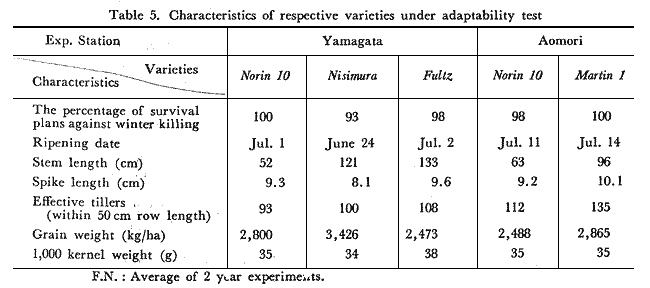Tests were made as the to percentage of survival plants and survival stems in the swelled seed beds with 100 plants of strains following F3. The cold and snow resistance of Norin 10 was stronger than either the local varieties or Norin 1, but it could not be said that Norin 10 is perfectly safe in the Tohoku district.
c) Reaction to diseases -
Yellow rust and leaf rust appeared to some extent every year, but any difference was noticed according to conditions of culture. There was, however, a serious outbreak of yellow rust in the spring of 1933 and of leaf rust in the spring of 1936. Norin 10 showed as high resistance as almost immune against yellow rust, but was damaged slightly by leaf rust.
Powdery mildew and red mould appeared in the years with moist climate just at the time when kernels were filling in. In Norin 10 it was observed that a serious outbreak occurred in the case of application of much fertilizer and dense planting, although the damage from red mould was fairly low.
d) Seed germination on spikes by rain fall -
In a variety with a short dormant period seeds tends to germinate on the spikes, while they are still standing, when there is much rain fall during the harvest time. Since Norin 10 exhibited an intermediate dormancy character, it could not be said that this variety is safe if there is much rain during the harvest time.
e) Grade of winter habit -
The grade of winter habit is usually divided into classes from I to VII in Japan. Classes I and II are spring wheat and are suited for southwestern moderate climates. The rests possess winter habits, among which classes III and IV are suited for autumn sowing in Kanto district, classes V and VI for Tohoku district and classes VI and VII for Hokkaido. Norin 10 was found to belong to class IV, while Fultz belonged to V.
7) Ecological adaptability tests:
Adaptability of Norin 10 were made in the 1932-33 and the 1933-34 crop years at five Agricultural Experiment Stations or Branch Stations in the Perfectures of Aomori, Akita, Yamagata and Fukushima. Due to wrong handling of seeds in the 1933-34 year test, poor germination was caused and uneven test results were obtained. Therefore, some of the odd results are not given in the table.
8) Norin 10 and local varieties in Iwate and Yamagata Prefectures:
In Iwate Prefecture local varieties had been those obtained by pure line selection of endemic varieties like Shisen 1 and Soshu 1 and of an introduced variety like Fultz 1, but in 1929 these varieties were replaced by the recommended varieties Norin 1 and Norin 2 (Shiro-Daruma x Velvet), while, Norin 10 became the recommended variety in 1935. In l942 31% of the wheat cultivation area in Iwate Perfecture was occupied by Norin 10. After that, however, there was a gradual decrease of this variety, and in 1953 it was replaced by Kokeshi-komugi. As compared with Norin 10, Kokeshi-komugi had higher cold and snow resistance, and therefore it gave more tillers and higher yield, especially in case of much fertilizer.
